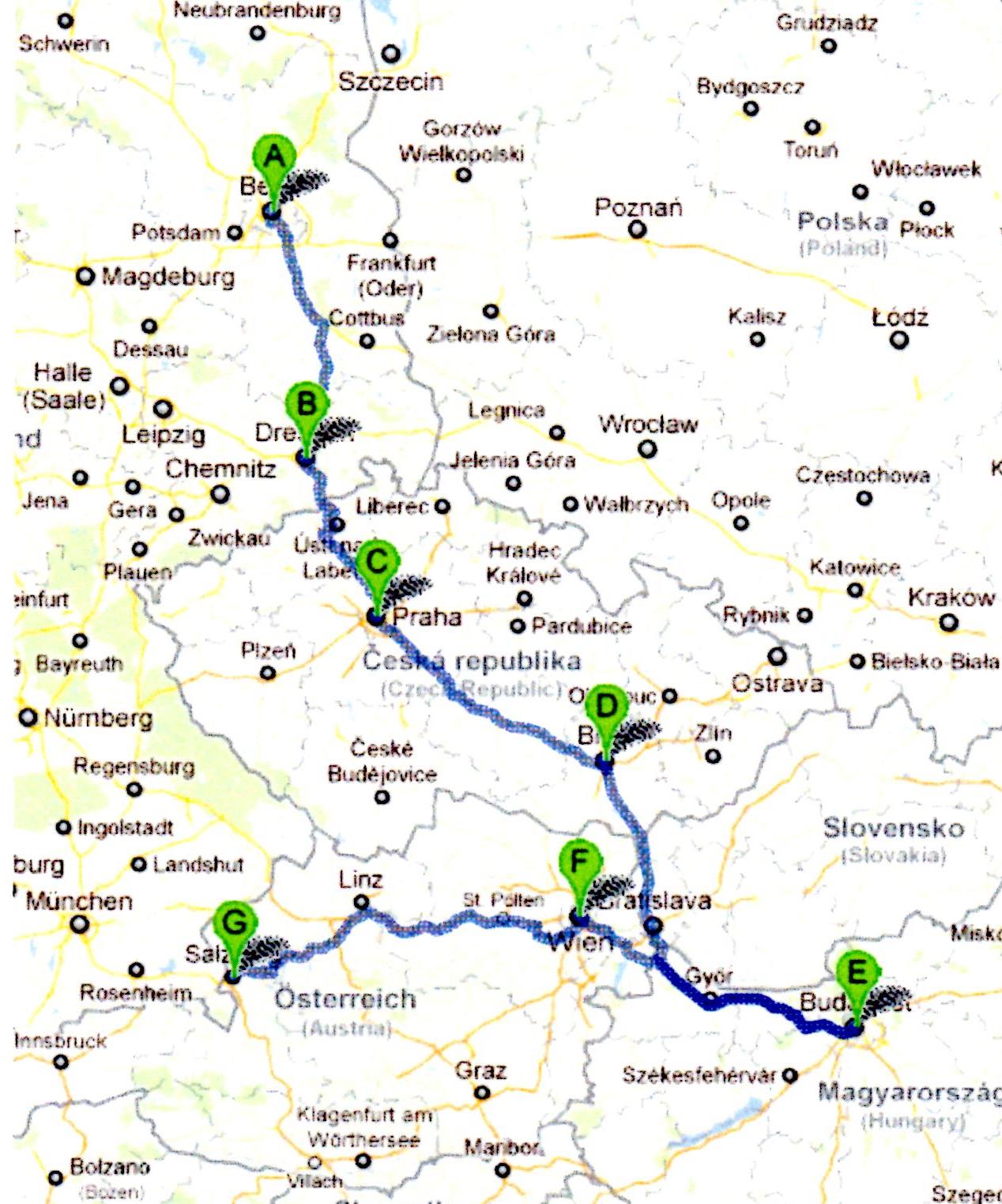CENTRAL
EUROPE 2011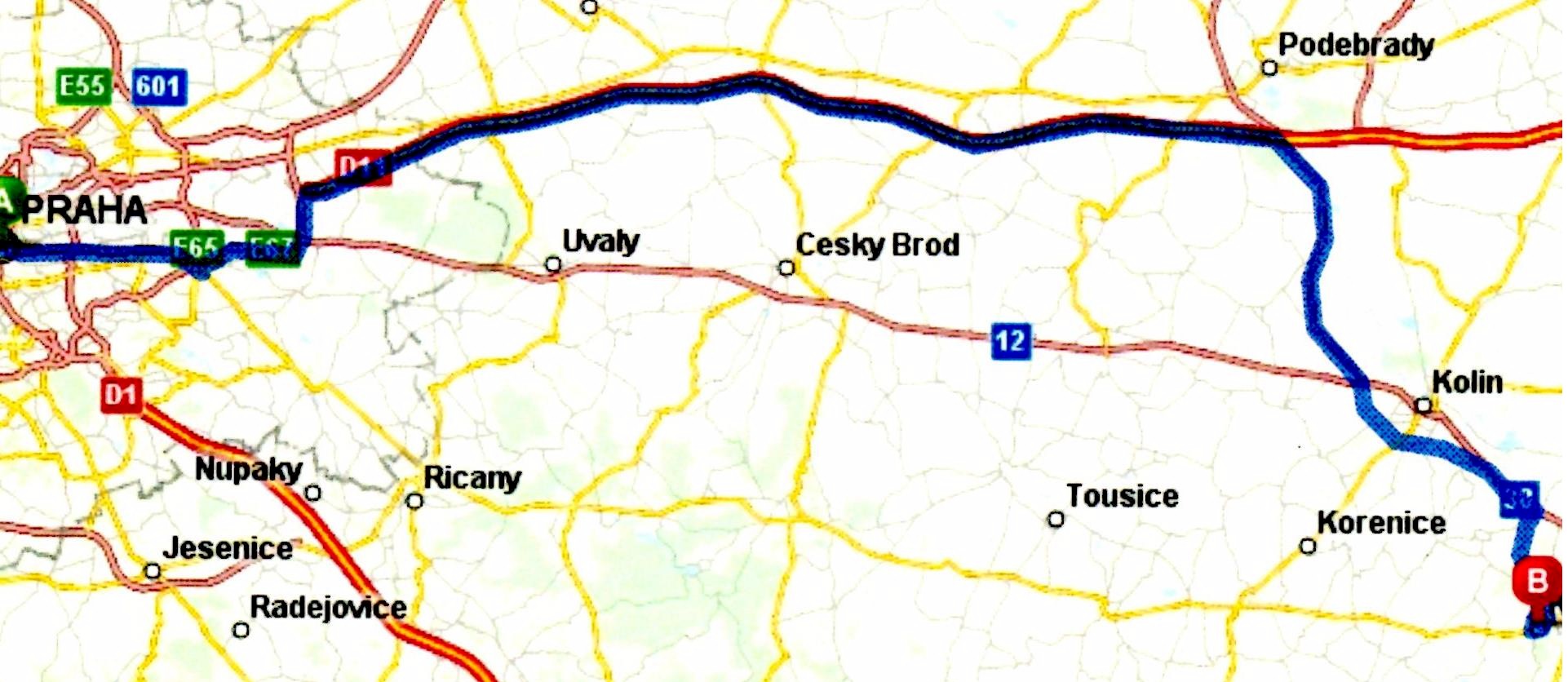
Day 9
Saturday, Sept 10
Prague
to Kutna Hora
We began our morning early in our beautiful palace parlor only to
discover that the milk that we bought yesterday for our cereal and coffee was
buttermilk...we couldn't read the label but it was in a case at the grocery with
cartons that looked like milk. Maybe the housekeeping staff will enjoy it after
we leave. We really wanted milk for our coffee and cereal.
The hotel called us an
"honest" taxi that took us to the train station for 280 crowns rather
than the 980 we spent to get there....100 crowns is equivalent to $6.00 US
dollars. We bought our train ticket
for Kunta Hora, and got on the right train for about an hour ride east.
A couple who took my cathedral class at the College of Southern Maryland
two years ago had brought me a model and a book from St. Barbara's cathedral in
Kunta Hora. I have made the
model,
and we wanted to see this amazing cathedral in person.
KUTNA HORA
The discovery of rich silver ore
deposit in the second half of the 13th century sparked an economic
boom in Kutna Hora that turned this sleepy miners’ settlement into the
second-most important town in Bohemia, rivaling Prague in terms of economic,
political and cultural importance. King
Wenceslas II declared it a royal town in 1307 and the Royal Mint, established in
Kutna Hora a year later, went on to produce roughly one-third of Europe’s
total production of silver. As the
town’s wealth grew, so did the number of grandiose palaces and churches.
Things started taking a turn for the worse at the beginning of the 16th
century. The gradual depletion of
ore deposits and the destruction cause by the Thirty Years’ War were the
industry’s final death blow, leading to the closing of the Royal Mint in 1727.
Today, Kutna Hora remains one of
Bohemias most popular day-trip destinations thanks in large part to its charming
historical center which joined UNESCO’s World /Cultural Heritage List in
December 1995.
We walked about a mile from the train station in Sedlec which is a small
town adjacent to Kutna Hora. We
passed a beautiful, very large church – Church of the Assumption of Mary and
St. John the Baptist. We wanted to
stop at the tourist office first. Right
up the street from the tourist office was what was known as the “Bone
Church.” We had read about it, and
decided that we really didn’t want to see it, but being this close we decided
to venture forth.
The Bone Church is a rather
macabre chapel decorated with the bones of about 40,000 people.
The story began in 1278 when King Otakar II sent Henry, the abbot of
Sedlec, on a diplomatic mission to Jerusalem.
Henry returned with a small amount of earth taken from Golgotha and
sprinkled it over the cemetery 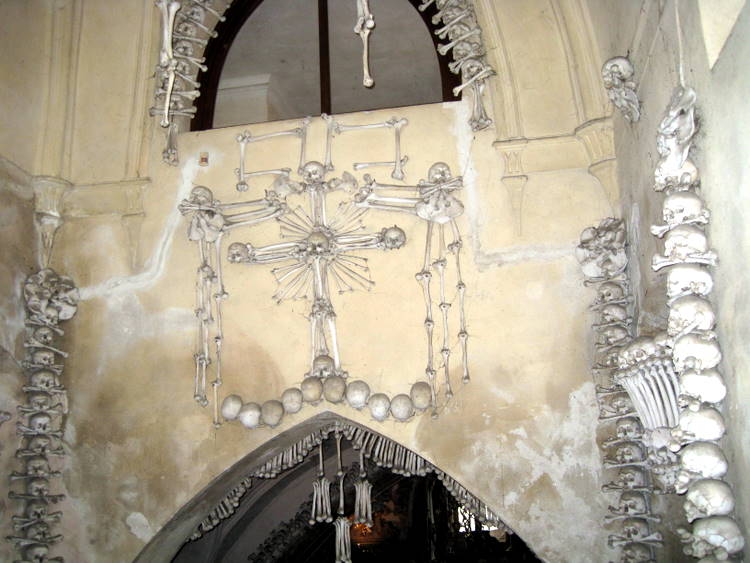 of Sedlec Monastery.
The grounds were declared holy and the cemetery grew in fame throughout
Central Europe. Soon it became the
most sought-after burial site of the powerful and wealthy.
of Sedlec Monastery.
The grounds were declared holy and the cemetery grew in fame throughout
Central Europe. Soon it became the
most sought-after burial site of the powerful and wealthy.
The bodies began piling up during the plague epidemics of the 14th
century and the Hussite Wars in the 15th century.
T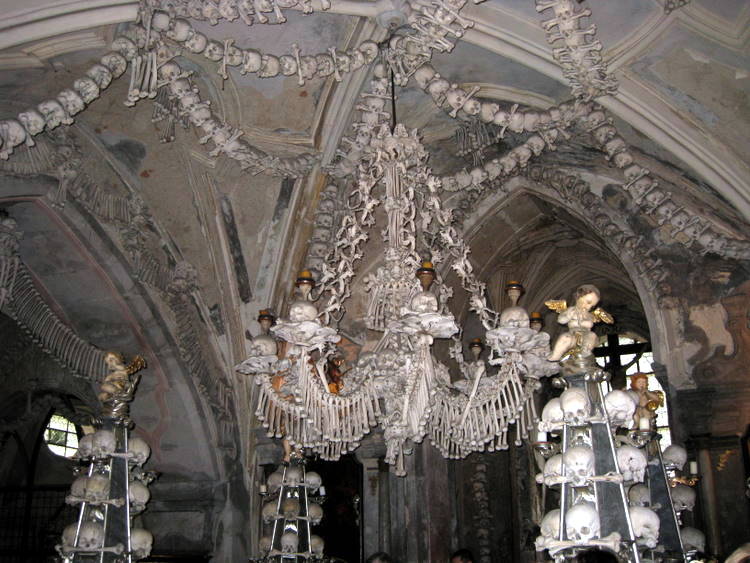 his prompted the building of an underground chapel that was to be the
final destination of the ever increasing number of remains. When the
Schwarzenberg family bought the monastery in the late 1800s, they hired local
woodcarver Franisek Rint, who found a solution to the huge number of century old
bones. The remarkable collection of
bones were arranged into crosses, columns, chalices, and monstrances, as well as
giant bells in each of the chapel’s corners and an enormous chandelier in the
center of the nave containing every bone in the human body. To say the least, it
was rather weird. They did allow photography.
his prompted the building of an underground chapel that was to be the
final destination of the ever increasing number of remains. When the
Schwarzenberg family bought the monastery in the late 1800s, they hired local
woodcarver Franisek Rint, who found a solution to the huge number of century old
bones. The remarkable collection of
bones were arranged into crosses, columns, chalices, and monstrances, as well as
giant bells in each of the chapel’s corners and an enormous chandelier in the
center of the nave containing every bone in the human body. To say the least, it
was rather weird. They did allow photography.
We walk back down the street
past the tourist office to the Church of the Assumption and St. John the
Baptist.
The origin of this church is
associated with the medieval expansion of the Order of Cistercians from France
through Germany to Bohemia, where their expansion continued by the establishment
of a Cistercian abbotship at Sedlec. There on the site of the original monastic
church, a huge Gothic church was erected in 1290-1320.
It is the oldest example of Gothic cathedral architecture from North
France in Central Europe. This
church was burned down during the Husssite revolution in 1421. Most of the five
hundred monks who tried to defend the monastery were killed, probably inside the
cathedral as indicated by skeletal findings in the alcoves in the northern wall.
The legend says that Hussite commander, Jan Zizka, ordered to spare the
church, but one of his officers did not obey his order and set the cathedral on
fire. The commander rewarded him
accordingly. He was ordered to melt gold and silver and pour it into his throat.
After this tragedy the monastery’s assets were forfeited and the church
remained in ruins for the next 278 years.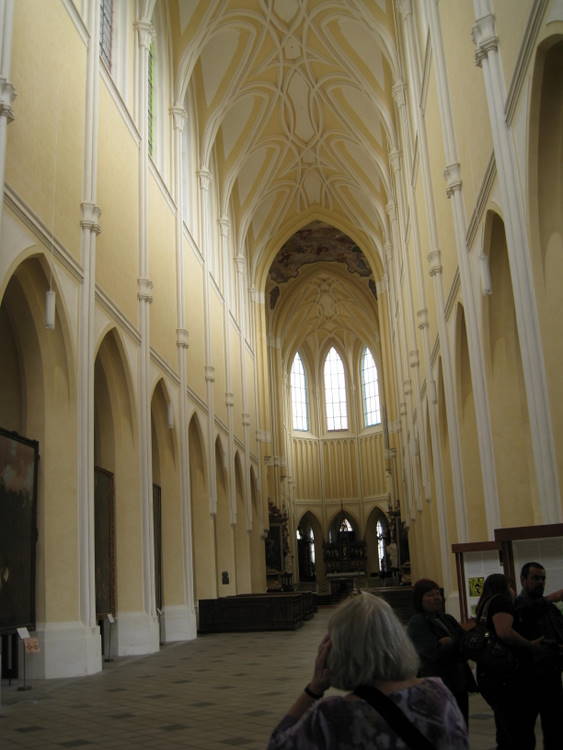
The church was restored in the
early 18th century by architect Jan Blazej Santini Aichel in the new
Baroque Gothic style. The vaulting of the nave was decorated with a network of
circular ribs. The imposing
architecture is integrated with Baroque decoration, which was created by the
most important personalities of Central Europe.
The building and its furnishings were a heavy burden for the
monastery’s cash, and after the last abbot died, the monastery was managed
until it was abolished in 1783 by Joseph II.
This was a disaster for the carefully and expensively created interior of
the church. Those things that could
be moved were sold in auction, the church closed down and deconsecrated.
It even used as storage for flour.

The cathedral was re-opened in
1806 as a parish church, and the monastery was rebuilt.
The last repair and renovation took place in 2001-2009 when the church
was re-consecrated after three hundred years, and restored to its original
purpose.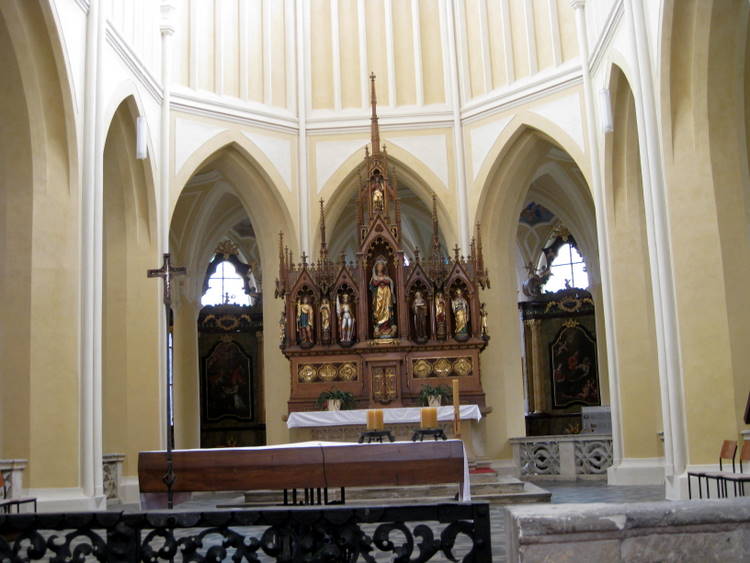
The interior was in a beautiful
cream/yellow color accented by white columns and molding.
The day was bright so the interior was well lit.
There were no stained glass windows. The ceiling vault was really
magnificent. In the vault of the
great crossing was a fresco depicting the Holy Trinity.
There were chapels with beautiful artwork around the apse.
vVery few people were visiting while we were there.
It was a good spiritual experience.
This part of town, Sedlec, was
some distance from St. Barbara’s Cathedral.
We went back to the tourist office to ask about transportation to St.
Barbara’s. There was a bus which
didn’t run too often on Saturday. He
sugge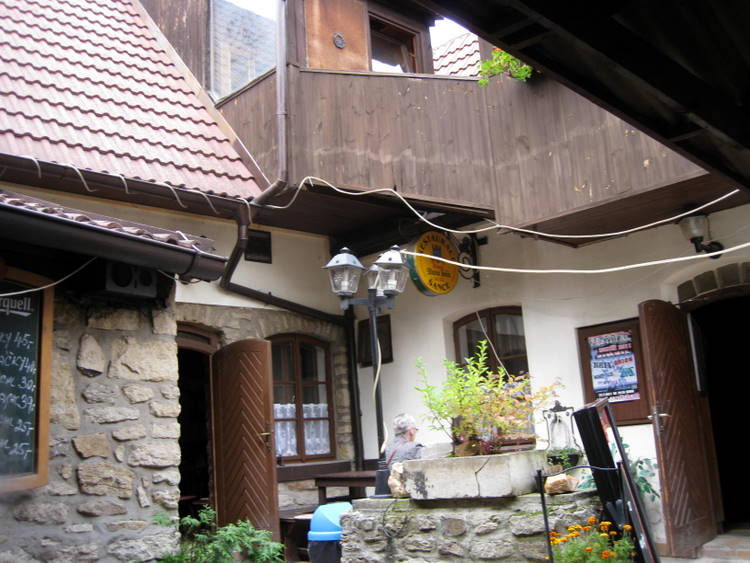 sted a tourist van which could be found outside the gate of the “Bone
Church”. We walked back up and
found the van but no driver. She was
in the “Bone Church” and was happy to give us a ride.
She let us out in front of St. Barbara’s.
We were hungry and found a wonderful little old neighborhood restaurant down
a block and across the street – Restaurace Sance.
The sign said they had been there since 1573.
We ate in an outdoor area which was stone on three sides and open towards
the entrance. It was very quaint.
I had fish and my wife had chicken.
The food was good and
sted a tourist van which could be found outside the gate of the “Bone
Church”. We walked back up and
found the van but no driver. She was
in the “Bone Church” and was happy to give us a ride.
She let us out in front of St. Barbara’s.
We were hungry and found a wonderful little old neighborhood restaurant down
a block and across the street – Restaurace Sance.
The sign said they had been there since 1573.
We ate in an outdoor area which was stone on three sides and open towards
the entrance. It was very quaint.
I had fish and my wife had chicken.
The food was good and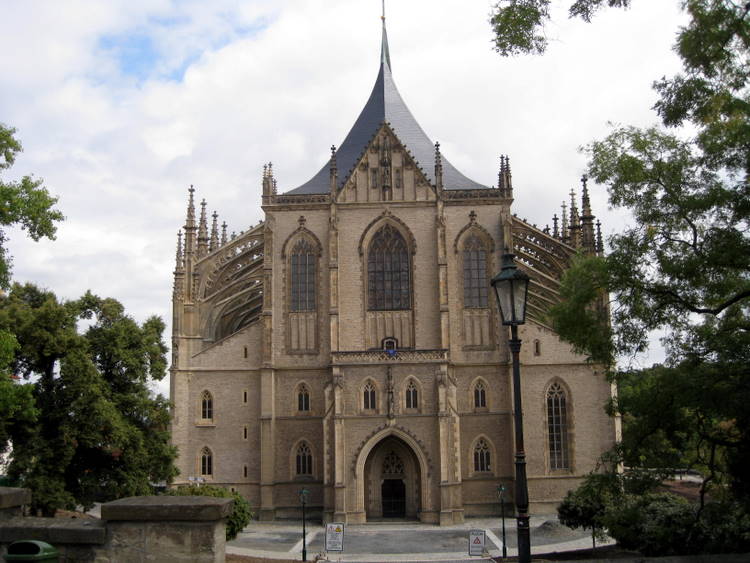 it was
fun to be eating near a group of elderly locals who were celebrating something.
it was
fun to be eating near a group of elderly locals who were celebrating something.
Named after the patron saint of
miners, St. Barbara, the cathedral of St. Barbara is one of the world’s most
remarkable examples of Gothic architecture.
Based on the initial designs of Peter Parler (who also designed St. Vitus
in Prague), construction began in 1388, but was interrupted for an extended
period of time due to the Hussite Wars. Work
on the building was completed in 1558. By then the silver mines and money began
to run out. Means for the further furnishing and maintenance 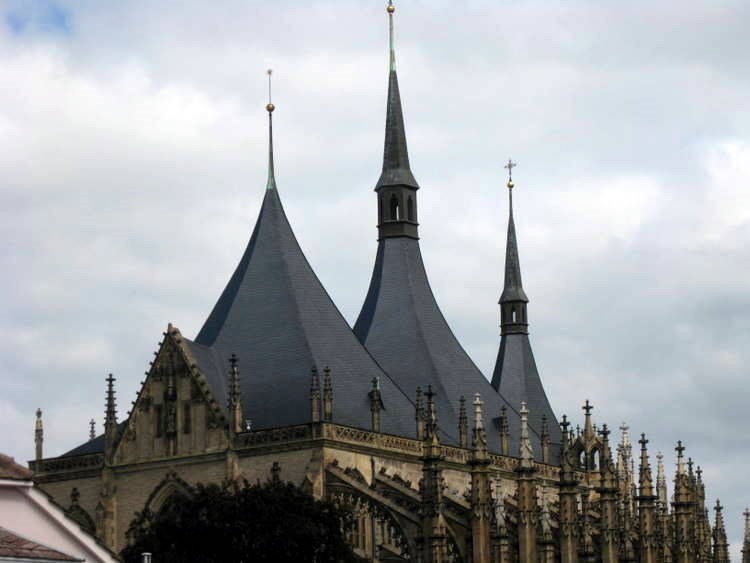 of the cathedral
were lacking. During the Thirty
Years’ War (1618-1648) many of its articles of precious metals were stolen,
sold and used, among other things, for the minting of coins.
of the cathedral
were lacking. During the Thirty
Years’ War (1618-1648) many of its articles of precious metals were stolen,
sold and used, among other things, for the minting of coins.
In 1626 the Jesuits arrived in
Kutna Hora and placed St. Barabara under their administration. They began to
carry out building modifications. The
most striking Baroque transformation was the replacement of the tent roofs with
a saddle roof with three turrets. Their
a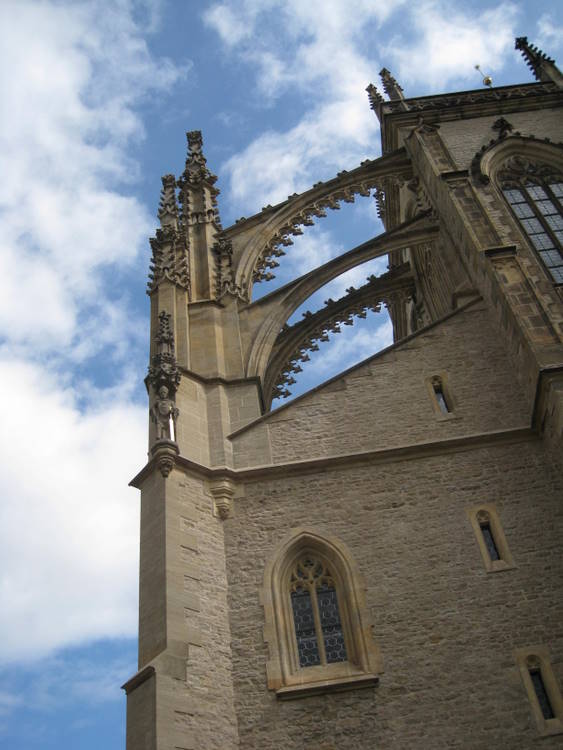 ctivities came to an end in 1773 with the departure of the order from Kutna
Hora. The church began to fall into decay. In
the 1870’s a society was formed for the restoration of St. Barbara’s.
The Baroque modifications were liquidated as well as the greater part of
the furnishing. Gothic elements were
renewed. In the 20th century the cathedral regained the three tent
roods and west façade was extended.
ctivities came to an end in 1773 with the departure of the order from Kutna
Hora. The church began to fall into decay. In
the 1870’s a society was formed for the restoration of St. Barbara’s.
The Baroque modifications were liquidated as well as the greater part of
the furnishing. Gothic elements were
renewed. In the 20th century the cathedral regained the three tent
roods and west façade was extended.
From the restaurant, we could
see the three tent roofs of St. Barbara’s.
Going back up the street, we arrived in front of the church which was
located much lower than the sidewalk. We stopped to take photos.
Having built the (SEE MY MODE
), I was familiar with all of the flying buttresses
and other exterior c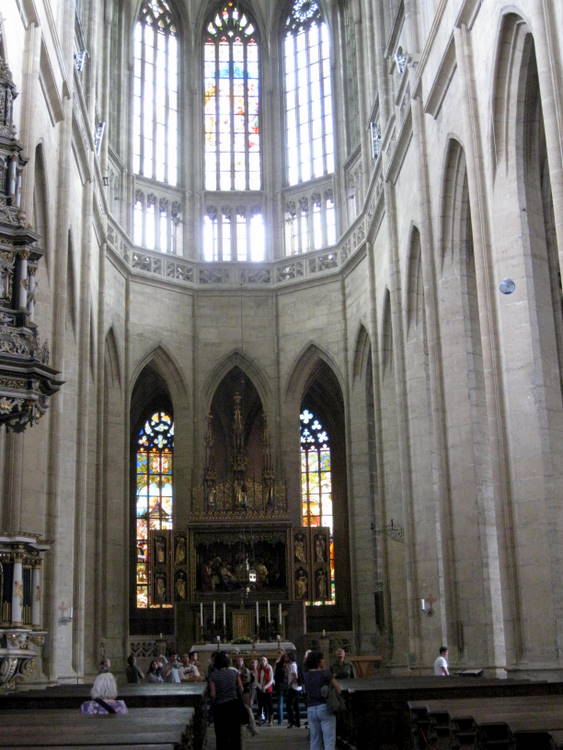 omponents. The
west façade is rather plain with a center entrance door flank by small windows
on each side, four small windows above the door.
The second level consists of a large central window with a smaller window
on each side. Work was being done on
the terraces leading from the street level to the plaza in front of the church.
omponents. The
west façade is rather plain with a center entrance door flank by small windows
on each side, four small windows above the door.
The second level consists of a large central window with a smaller window
on each side. Work was being done on
the terraces leading from the street level to the plaza in front of the church.
The main entrance was through
the north transcept. Just as we were ready to go in three old airplanes did a
number of maneuvers over the area.
The
inside was spectacular especially the ceiling.
We had seen photos plus a Teaching Company lecture which highlighted St.
Barbara’s ceiling. The style is
known as Helical Vaulting. The
center section of the vault has the appearance of a number of six petal flowers.
The vaults are covered with emblems representing guilds, fraternities,
important persons and the names of the Sacraments and Virtues.
Around the exterior wall and in apse are small chapels.
Above the Neo-Gothic high al tar are windows with only the center being
stained glass. Overhead in the
nave are four large statues representing Justice, Bravery, Caution and
Temperance. There were large stained
glass windows at the nave level which were made of brilliant colors.
The sun was shining which made them even more spectacular.
As we left, I stopped at the small gift shop in the transept.
I didn’t see any models of the church like I had.
They told me they were no longer published.
I am so fortunate to have one. We
went back outside where I took more photos.
There were wonderful gargoyles.
tar are windows with only the center being
stained glass. Overhead in the
nave are four large statues representing Justice, Bravery, Caution and
Temperance. There were large stained
glass windows at the nave level which were made of brilliant colors.
The sun was shining which made them even more spectacular.
As we left, I stopped at the small gift shop in the transept.
I didn’t see any models of the church like I had.
They told me they were no longer published.
I am so fortunate to have one. We
went back outside where I took more photos.
There were wonderful gargoyles.
CHAPEL OF CORPUS CHRISTI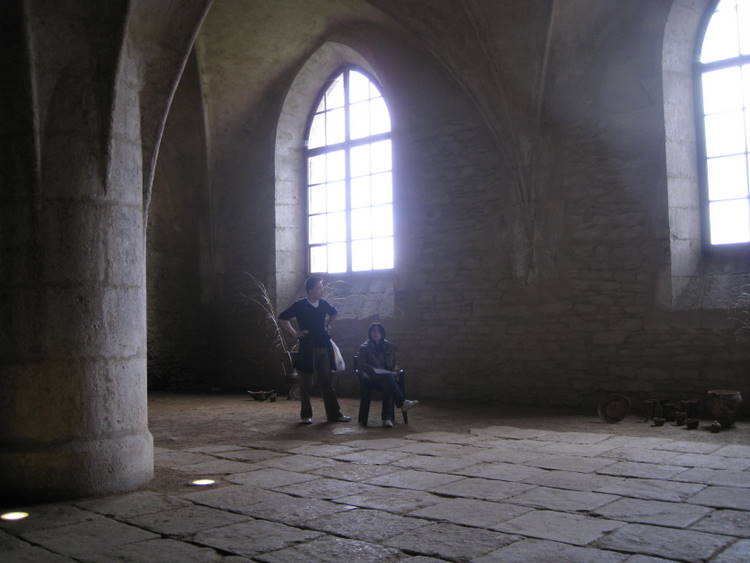
The back of the cathedral was on
top of a rather steep cliff with the town below.
Next to the cathedral was the Chapel of Corpus Christi.
This inconspicuous
structure was there before the construction of St. Barbara’s Cathedral. At
that time, the Brotherhood of Corpus Christi established a cemetery chapel with
an ossuary inspired by the “Bone Church” in Sedlec. There was a small door
that led to a steep set of stairs leading down into a large hall. The chapel
remained in the original shape until the arrival of the Jesuits who, in
connection to the construction of the Jesuit College, initiated a series of
reconstructions resulting in a new entrance with a Baroque portal. Upon the
exodus of the Jesuit order, the Chapel of Corpus Christi was transformed to
serve as an organ workshop and soon began to decay. In 1997 – 2000, the entire
structure was subject to major reconstruction and nowadays it is accessible for
public and used for small cultural events. We
went down and observed several displays of pottery.
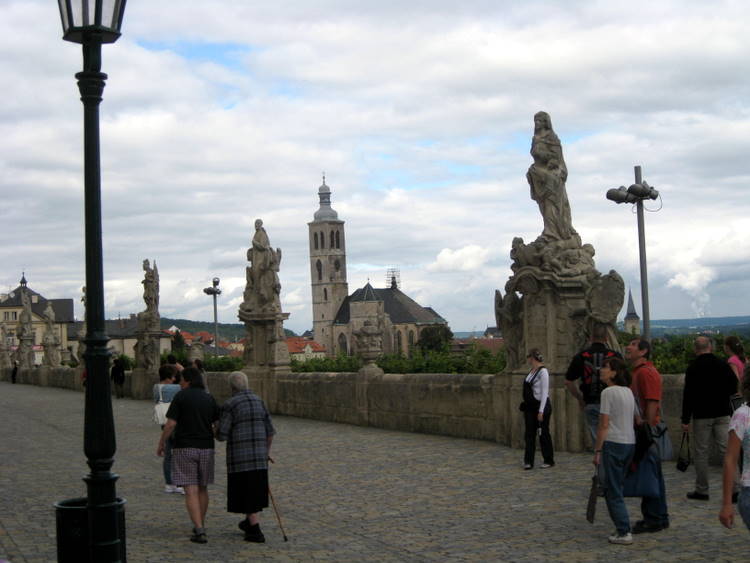
On the opposite side of the
walkway was the Jesuit College. It
was built between 1667 and 1703. It
was designed in an F-shaped ground plan to remind people of the Habsburg kings
Ferdinand II and Ferdinand III. The
front façade resembles Italian palaces of the early Baroque period. The
artificial terrace in front of the College was enclosed by a low wall with 13
sculptures of saints favored by the Jesuits, including St. Ignatius of Loyola,
St. Wenceslas and others. It was designed as a resemblance of the Charles Bridge
in Prague.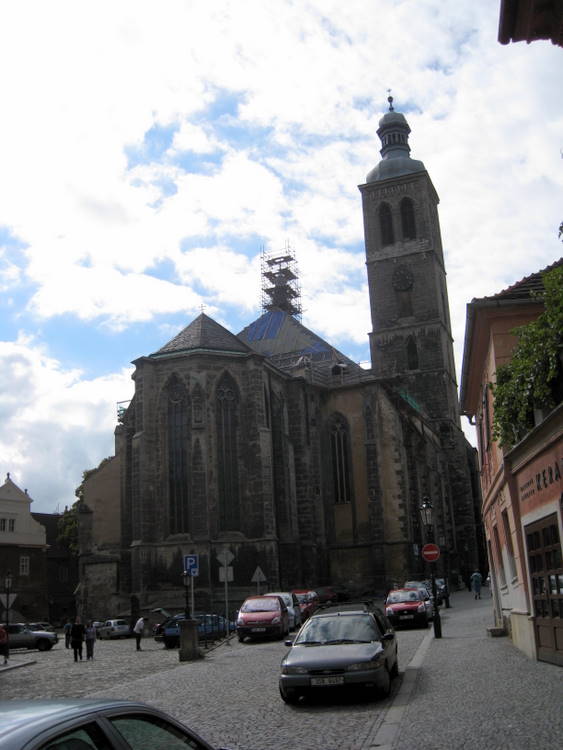
We decided that we would walk
down to visit St. James Church.
It
was rather steep with the street
covered with cobblestone. The views were beautiful and the walk charming. We
came to St. James church but it was closed for renovation. Its construction was
initiated in 1330 by German patricians and supposedly also by minters and
coiners from the adjacent mint in the Italian Court who wished to have a church
nearby. The main core of the church was completed around 1380 with architects
from Peter Parler’s workshop taking part in the designing of the western façade,
but construction works continued until 1420.
THE ITALIAN COURT
Further down the hill, we came
to the Italian Court. The origins of the Italian Court are shrouded in mystery
and historians can only guess because no written resources and only a few
artifacts dating from the earliest history of the building have been preserved.
Presumably there was a little fortified castle that was later chosen by the
sovereign to become the seat of the new Central Mint. Since the very beginning,
the Italian Court was separated from the town by fortified moats to protect the
workshops, in which silver was processed and coins were struck. The original
building was reconstructed at the turn of the 15th century, allegedly upon the
request of King Wenceslas II, and the chapel and the royal palace were added.
The Italian Court thus remained virtually unchanged until the end of the 18th
century, when the mint and the mining office were abolished and the building
began to decay. A century passed and the condition was critical, some people
even called for its demolition. Eventually in the 1880s, municipal authorities
decided to carry out a vast reconstruction project under the direction of the
famous architect Ludvík Lábler. The project involved the removal of ruined
workshops; what remained were the royal palace, the treasury and the chapel that
was redecorated in the Art Nouveau style. We
didn’t have time to go in but we sat in the courtyard for a while. It was very
peaceful. On the front was a small
café but we had decided that we wanted ice cream which they didn’t have.
So we walk a little farther and were soon in a large plaza with a number
of cafes.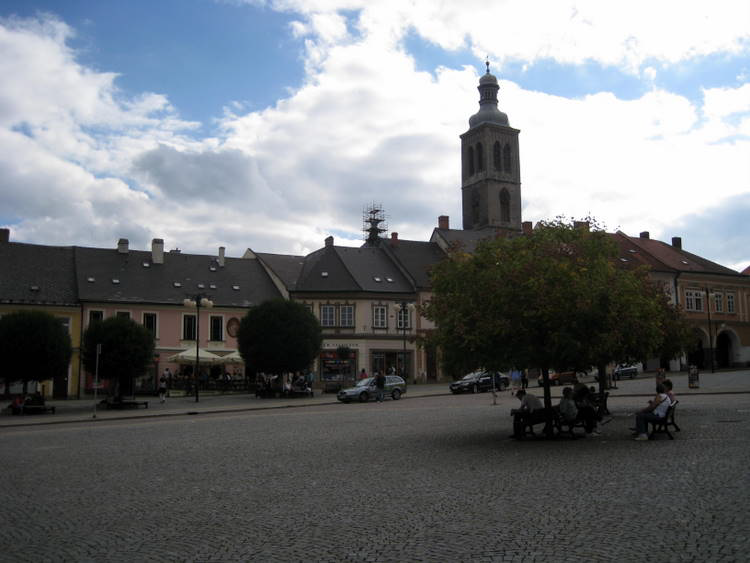
We found an attractive outdoor
café that had a wonderful ice cream menu. We
were really “bad” but it was sooo good.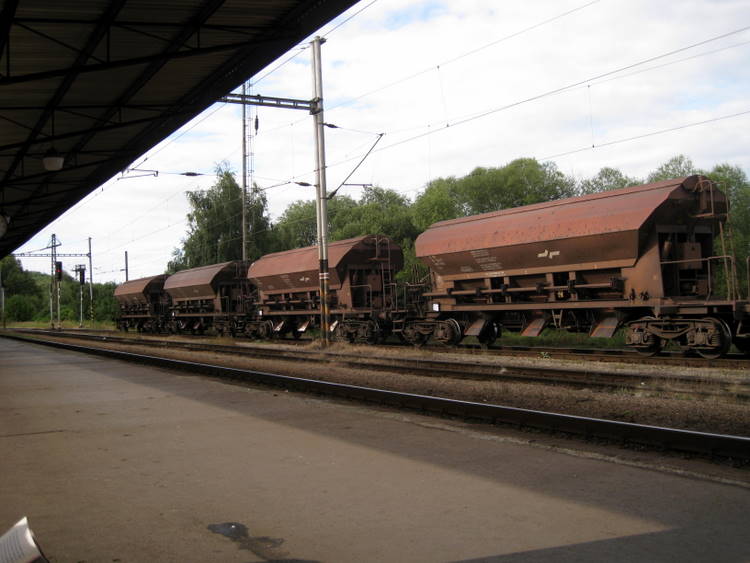
We had planned on catching the
5:00 PM train back to Prague, and weren’t sure how long the taxi ride to the
station would be. We had noted taxis
near where we had the ice cream so decided to take the taxi back to the train
station about 4:15. At the train station, we sat on a bench on the platform. It
was a very small station. The
quietness of the wait was very relaxing. At times there was complete silence. Around
5:00 pm people started arriving and it got noisy. We were supposed to catch the
5:00 PM train but it was about 25 minutes late.
On our trip to Knuta Hora we shared a compartment with woman who could
talk to us in English although they spoke to each other in Czech.
They had been helpful in giving some directions.
We went back to Prague on the same train with them, and we shared the
same compartment again. Not only was
the train late to begin with, it broke down on the way back to Prague so they
had to put on a new engine.
It
was 6:45 when we got back to Prague – 45 minutes late.
We had forgotten to bring our Prague maps and we weren't going to get
robbed again by the yellow cabs. We
found a hotel across from the train station and the desk clerk told us how to
take the tram back to our hotel.
We hadn’t made any dinner
reservations. The wonderful
restaurant in our hotel was booked for a wedding party.
We had remembered seeing a restaurant on the street behind our hotel that
had a Trip Advisor ad on the door. It
was booked for the evening. We went
back towards our hotel a few feet and found another restaurant in the Hotel
Leonardo – Platina. Part of the restaurant an open air courtyard. We sat in
the courtyard. The evening was
called a barbeque dinner. The menu
consisted of a number of delicious looking items to be cooked on the grill in
the courtyard. There was an
extensive salad bar in the next room. Live music
was provided by a fellow who played the piano and sang…even a few old
American favorites. My wif e had trout, and I had a beef, pork and chicken shish
kabob. I couldn’t eat all the beef
as it was very tough but had a good flavor. It
was a fun place to eat.
e had trout, and I had a beef, pork and chicken shish
kabob. I couldn’t eat all the beef
as it was very tough but had a good flavor. It
was a fun place to eat.
When we got back to the hotel,
the wedding dinner was nearing completion. At
the entrance were four beautiful little children – two boys and two girls –
dressed in the traditional dress offering us plates of desserts from the
wedding. They even supplied a fork.
It was a long but very enjoyable
day.

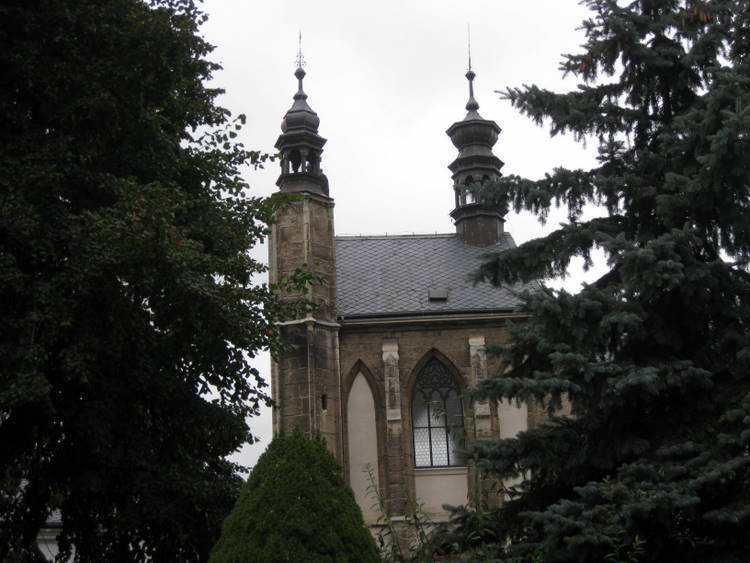
 of Sedlec Monastery.
The grounds were declared holy and the cemetery grew in fame throughout
Central Europe. Soon it became the
most sought-after burial site of the powerful and wealthy.
of Sedlec Monastery.
The grounds were declared holy and the cemetery grew in fame throughout
Central Europe. Soon it became the
most sought-after burial site of the powerful and wealthy.  his prompted the building of an underground chapel that was to be the
final destination of the ever increasing number of remains. When the
Schwarzenberg family bought the monastery in the late 1800s, they hired local
woodcarver Franisek Rint, who found a solution to the huge number of century old
bones. The remarkable collection of
bones were arranged into crosses, columns, chalices, and monstrances, as well as
giant bells in each of the chapel’s corners and an enormous chandelier in the
center of the nave containing every bone in the human body. To say the least, it
was rather weird. They did allow photography.
his prompted the building of an underground chapel that was to be the
final destination of the ever increasing number of remains. When the
Schwarzenberg family bought the monastery in the late 1800s, they hired local
woodcarver Franisek Rint, who found a solution to the huge number of century old
bones. The remarkable collection of
bones were arranged into crosses, columns, chalices, and monstrances, as well as
giant bells in each of the chapel’s corners and an enormous chandelier in the
center of the nave containing every bone in the human body. To say the least, it
was rather weird. They did allow photography.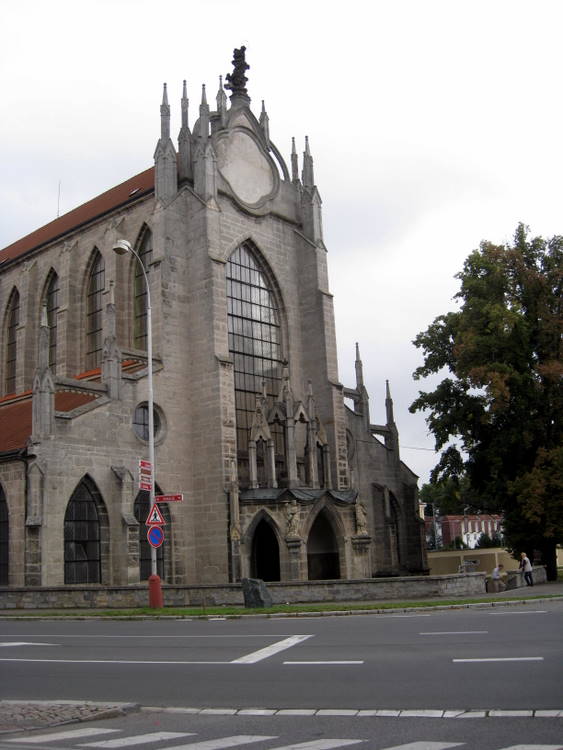




 sted a tourist van which could be found outside the gate of the “Bone
Church”.
sted a tourist van which could be found outside the gate of the “Bone
Church”. it was
fun to be eating near a group of elderly locals who were celebrating something.
it was
fun to be eating near a group of elderly locals who were celebrating something. of the cathedral
were lacking.
of the cathedral
were lacking. ctivities came to an end in 1773 with the departure of the order from Kutna
Hora. The church began to fall into decay.
ctivities came to an end in 1773 with the departure of the order from Kutna
Hora. The church began to fall into decay. omponents.
omponents.








 e had trout, and I had a beef, pork and chicken shish
kabob.
e had trout, and I had a beef, pork and chicken shish
kabob.